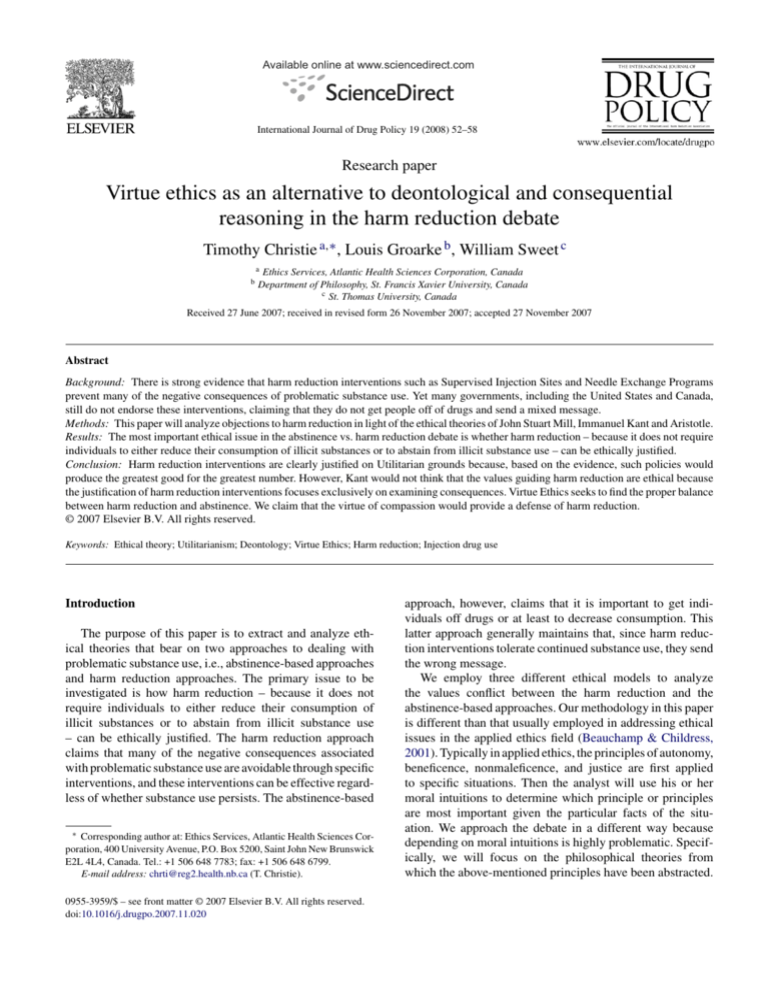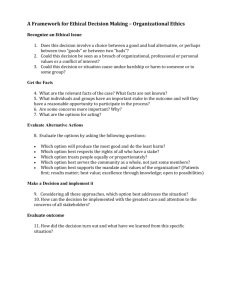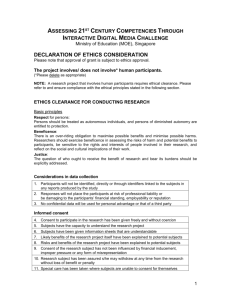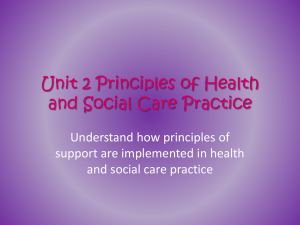
Available online at www.sciencedirect.com
International Journal of Drug Policy 19 (2008) 52–58
Research paper
Virtue ethics as an alternative to deontological and consequential
reasoning in the harm reduction debate
Timothy Christie a,∗ , Louis Groarke b , William Sweet c
a
b
Ethics Services, Atlantic Health Sciences Corporation, Canada
Department of Philosophy, St. Francis Xavier University, Canada
c St. Thomas University, Canada
Received 27 June 2007; received in revised form 26 November 2007; accepted 27 November 2007
Abstract
Background: There is strong evidence that harm reduction interventions such as Supervised Injection Sites and Needle Exchange Programs
prevent many of the negative consequences of problematic substance use. Yet many governments, including the United States and Canada,
still do not endorse these interventions, claiming that they do not get people off of drugs and send a mixed message.
Methods: This paper will analyze objections to harm reduction in light of the ethical theories of John Stuart Mill, Immanuel Kant and Aristotle.
Results: The most important ethical issue in the abstinence vs. harm reduction debate is whether harm reduction – because it does not require
individuals to either reduce their consumption of illicit substances or to abstain from illicit substance use – can be ethically justified.
Conclusion: Harm reduction interventions are clearly justified on Utilitarian grounds because, based on the evidence, such policies would
produce the greatest good for the greatest number. However, Kant would not think that the values guiding harm reduction are ethical because
the justification of harm reduction interventions focuses exclusively on examining consequences. Virtue Ethics seeks to find the proper balance
between harm reduction and abstinence. We claim that the virtue of compassion would provide a defense of harm reduction.
© 2007 Elsevier B.V. All rights reserved.
Keywords: Ethical theory; Utilitarianism; Deontology; Virtue Ethics; Harm reduction; Injection drug use
Introduction
The purpose of this paper is to extract and analyze ethical theories that bear on two approaches to dealing with
problematic substance use, i.e., abstinence-based approaches
and harm reduction approaches. The primary issue to be
investigated is how harm reduction – because it does not
require individuals to either reduce their consumption of
illicit substances or to abstain from illicit substance use
– can be ethically justified. The harm reduction approach
claims that many of the negative consequences associated
with problematic substance use are avoidable through specific
interventions, and these interventions can be effective regardless of whether substance use persists. The abstinence-based
∗ Corresponding author at: Ethics Services, Atlantic Health Sciences Corporation, 400 University Avenue, P.O. Box 5200, Saint John New Brunswick
E2L 4L4, Canada. Tel.: +1 506 648 7783; fax: +1 506 648 6799.
E-mail address: chrti@reg2.health.nb.ca (T. Christie).
0955-3959/$ – see front matter © 2007 Elsevier B.V. All rights reserved.
doi:10.1016/j.drugpo.2007.11.020
approach, however, claims that it is important to get individuals off drugs or at least to decrease consumption. This
latter approach generally maintains that, since harm reduction interventions tolerate continued substance use, they send
the wrong message.
We employ three different ethical models to analyze
the values conflict between the harm reduction and the
abstinence-based approaches. Our methodology in this paper
is different than that usually employed in addressing ethical
issues in the applied ethics field (Beauchamp & Childress,
2001). Typically in applied ethics, the principles of autonomy,
beneficence, nonmaleficence, and justice are first applied
to specific situations. Then the analyst will use his or her
moral intuitions to determine which principle or principles
are most important given the particular facts of the situation. We approach the debate in a different way because
depending on moral intuitions is highly problematic. Specifically, we will focus on the philosophical theories from
which the above-mentioned principles have been abstracted.
T. Christie et al. / International Journal of Drug Policy 19 (2008) 52–58
For example, the principle of autonomy is abstracted from
Deontological ethics, beneficence and nonmaleficence from
Utilitarianism, and the principle of justice was originally
articulated by Aristotle who is a key source of contemporary Virtue Ethics. The advantages of our approach are, first,
it directly addresses what are clearly the three most influential models in contemporary ethical thought and, second, it is
more robust than simply referring to abstract principles and
then using intuitions to determine which principle is most
important.
53
harm reduction movement. Some advocates argue for complete legalization of illicit drugs and radical drug law reform
(Hankins, 2000), while others argue for a medical model that
is more cautious (Anderson, 2000). We address the advocacy
issue peripherally in the sense that we think harm reduction makes ethical sense, is superior to alternative policy
approaches to problematic substance use, and can surmount
the standard ethical objections to it.
Criticisms of harm reduction
Harm reduction
To discuss harm reduction it is necessary to identify (1) its
fundamental assumptions and definition, (2) specific kinds
of harm reduction interventions and (3) the implications
of the political advocacy of many harm reduction proponents.
The fundamental assumption of harm reduction, which
is the primary focus of this paper, is that it is important to
try to reduce drug-related harm (Erickson, Butters, & Walko,
2007). The harm reduction approach does not require individuals to reduce or abstain from drug use; rather it attempts to
mitigate the negative consequences of drug use. Abstinence
could be an eventual outcome and is consistent with harm
reduction; however, abstinence is not a condition of the harm
reduction approach.
There are numerous kinds of harm reduction interventions, and they apply in different ways depending on the
particular substances and activities involved: illicit opiates,
cocaine, ecstasy, alcohol, tobacco, etc. The specific interventions discussed in this paper are needle exchange programs
and supervised injection sites. Not all harm reduction interventions have the same ethical justification. For example,
needle exchange programs and supervised injection sites
assist individuals who are already engaged in an activity. If
an individual is going to inject drugs regardless of the harms
involved, needle exchange gives that person clean needles
and a supervised injection site provides a medical setting in
which the person can inject the drugs, but in neither case does
the intervention involve supplying the substance. The ethical
justification for other harm reduction interventions would be
different. For instance, heroin prescription programs actually
provide the substance to individuals, which is different than
simply providing sterile equipment or supervising injections.
Noting this difference is not to make the judgment that there
may be something ethically problematic with heroin prescription; it simply recognizes that the situation is different and,
therefore, the ethical justification may be different. For the
sake of simplicity, we have chosen to focus on the generic
philosophical aspects of harm reduction, with specific references to needle exchange programs and supervised injection
sites, when necessary.
Finally, as with any important development in public
policy, there are elements of political advocacy within the
The most important ethical concern with harm reduction
is related to the “value-judgment” that it is more important to
reduce the harms associated with drug use than it is to reduce
or prohibit drug use. The controversial character of this value
judgment is amplified because the relevant drugs are illegal.
Critics of harm reduction have argued that (1) it encourages
drug use, (2) it sends a mixed message, and (3) it fails to get
people off of drugs.
There is a significant amount of the literature, however,
supporting the claim that harm reduction interventions do
not increase or encourage drug use. In fact, the evidence
demonstrates the opposite. The experience of the Canadian supervised injection site shows that some patients, who
would not have otherwise sought treatment, eventually seek
treatment, including abstinence-based programs, as a result
of using the site (Tyndall et al., 2005). This is consistent
with what has been observed in needle exchange programs
as well; participants frequently seek referrals for treatment
(Strathdee, Celentano, & Shah, 1999; Hagan, McGough, &
Thiede, 2000). Based on what is currently known, the claim
that harm reduction programs encourage drug use is unsubstantiated.
The second criticism of harm reduction is that it “sends
a mixed signal.” This objection was made in a 1996 letter
to the Governor’s Advisory Council on AIDS (Whitman,
1996). In this letter, Christine Whitman, the former Governor
of New Jersey, acknowledges that the National Academy of
Science and the Centers for Disease Control and Prevention
endorse needle exchange programs as effective interventions
for interrupting the spread of HIV. She argues, however, that
needle exchange programs “send a mixed signal” and that
Governments should not “be in the business of facilitating
illegal activity.” These sentiments are echoed in the United
States’ National Drug Control Strategy, which states that
(1) there should be no tolerance for substance use whatsoever (ONDP, 2007a), (2) it is essential to deter substance
use (ONDP, 2007b) and (3) it is imperative to disrupt illegal drug markets (ONDP, 2007c). The impetus for these
objections is the belief that any policy that tolerates drug
use sends a “mixed signal” and frustrates primary prevention
efforts.
It seems, however, that these arguments are simply a
restatement of the first objection, namely that harm reduction
will encourage illegal drug use. For example, if the outcome
54
T. Christie et al. / International Journal of Drug Policy 19 (2008) 52–58
of encouraging illegal drug use was not relevant to this argument, it is difficult to understanding what “sending a mixed
signal” would mean or why it would even be a relevant consideration. The significance of this objection is mitigated by
the same evidence that invalidates the first objection.
A third criticism of harm reduction is found in the following quotation from the (current) Canadian Federal Minister
of Health, Tony Clement:
Do safe injection sites contribute to lowering drug use and
fighting addiction? Right now the only thing the research
to date has proven conclusively is [that] drug addicts need
more help to get off drugs. Given the need for more facts,
I am unable to approve the current request to extend the
Vancouver site for another three and a half years (Health
Canada, 2006).
Scientific evaluation of the Canadian supervised injection
site revealed that the facility attracted drug users who were
formerly most likely to inject in public and be at highest risk
of HIV infection and death due to overdose (Wood, Kerr,
& Montaner, 2004a; Wood, Kerr, & Small, 2005a; Wood,
Tyndall, & Li, 2005b). The opening of the supervised injection site was followed by statistically significant reductions
in public drug use and publicly discarded syringes (Wood
et al., 2004b); was associated with reduced syringe sharing
and other forms of HIV risk behaviour (Kerr, Tyndall, Li,
Montaner, & Wood, 2005); and was a key referral mechanism
to addiction treatment and other community resources including abstinence-based programs (Tyndall et al., 2005). It was
not associated with increased drug use or other drug-related
problems (Kerr et al., 2006).
The Minister’s reasoning, however, suggests that it is
more important to “contribute to lowering drug use [,] fighting addiction” and getting people “off drugs” than it is to
achieve these outcomes. This belief is so strongly held that
the Minister refused to renew the Section 56 exemption to the
Controlled Drugs and Substances Act given to the supervised
injection site, which will make it illegal for the site to operate
after this exemption expires in June 2008.
This is a substantive objection to the theoretical underpinnings of harm reduction and requires a careful ethical
analysis. If a program will get people off of drugs, then the
Minister would seem to approve of it; if it does not get people
off of drugs, the Minister is definitely against it, even if the
program otherwise avoids many of the negative consequences
of illicit drug use. Embedded in this objection is the valuesbased preference for an abstinence-based approach to drug
policy. The abstinence-based approach differs from harm
reduction in a very important respect; it requires the individual either to abstain from drugs or attempt to abstain from
drugs (Christie & Anderson, 2003; Tammi & Hurme, 2007).
The harm reduction approach, however, does not require the
individual to either abstain from or reduce consumption of
illicit drugs. It simply seeks to prevent the negative consequences of illicit substance use.
Ethical analysis
In his recent article entitled “Ethics and drug policy,” Alex
Wodak argues that the scientific debate about harm reduction is over (Wodak, 2007a). Harm reduction works. The
real conflict, which has largely been overlooked, is about
ethics. More specifically, it is a revival of the debate between
Utilitarian and Deontological approaches to ethics. Wodak
claims that, implicit in the reasoning of harm reduction advocates, is a Utilitarian argument, which holds that the key
guideline in ethics is that if negative consequences can be
avoided they should be avoided. Abstinence advocates, however, generally seem to employ a Deontological ethic, which
maintains that the moral worth of one’s actions has nothing to do with the consequences of those actions but, rather,
is determined by the intention of the actors. Our analysis
will examine this debate in more depth. We will present and
interpret the ethical theories of the Consequentialist Utilitarian, John Stuart Mill, of the founder of Deontological
ethics, Immanuel Kant, and Aristotle’s Virtue Ethics, which
many see as a remedy to the Consequentialist–Deontological
dilemma.
Utilitarianism (John Stuart Mill)
John Stuart Mill was a 19th century British philosopher
who was seminal in the development of liberalism (Arnold,
2006) and is still recognized as one of the key proponents of
Utilitarianism (Mill, 1863). His theory of liberty holds that
individuals in society should have broad ranging freedoms,
such as liberty of thought, discussion, association, and the
right to pursue their own life goals as they see fit. The only
justifiable limit to an individual’s liberty occurs when that
person’s actions will harm others. This is called the ‘harm
principle.’ (Mill did not consider merely giving offence or
causing inconvenience as harm. He thought if harm were
defined to include these ways, individuals could be prevented
from criticizing social conventions.) His contention was that
by restraining the state’s ability to interfere with the liberty
rights of individuals, the long-term consequences for society
will be positive.
Many liberal theorists root their theories in some conception of ‘natural’ or ‘human rights.’ They maintain that rights,
such as the rights to life, liberty and property, are natural,
inalienable, and intrinsically valuable. However, Mill thinks
that individual liberty rights are instrumental, i.e., good for
the sake of achieving something else. This idea is rooted in
his commitment to Utilitarianism. Utilitarianism is the theory
which contends that the foundation of morality is the greatest happiness principle, and holds that an action is right if it
tends to promote the greatest happiness for the greatest number and wrong if it tends to produce the opposite of happiness.
Happiness is defined as pleasure and the absence of pain and
unhappiness is defined as pain and the privation of pleasure.
Mill contends that pleasure and freedom from pain are the
T. Christie et al. / International Journal of Drug Policy 19 (2008) 52–58
only things that are intrinsically valuable and that everything
else is instrumental to them.
When determining what will produce happiness, Mill is
not focusing just on the agent’s own happiness, but on that
of the entire community. In determining this, each agent has
one ‘vote.’ For the Utilitarian, the consequences for the community are of fundamental importance, and when calculating
the consequences we must consider all relevant variables,
including the difference between short-term and long-term
consequences. For example, an action might produce much
happiness in the short-term but, in the long-term, result in
more harm than good; or the opposite might be true.
With regard to harm, Mill’s ‘liberal’ view clearly makes
allowances for individuals to harm themselves (e.g., to
consume alcohol to excess). But if drunkenness leads an individual to neglect his or her responsibilities or to interfere with
others, Mill would allow the state to intervene. The ethical
issue is not the drinking or the harm to oneself, but the individual fulfilling his or her responsibilities—although drinking is
the cause of the failure to carry out one’s responsibilities. If a
person could drink and not harm society, Mill would certainly
not allow the state to interfere with that person’s liberty.
This bears on the current discussion about drug use. Consider, for example, the harms of injection-related infections,
overdoses, blood borne disease, violence, property crime,
involvement in the sex trade, and incarceration (Kerr &
Palepu, 2001; Hunt, 2005) The cost for every untreated opiate user is estimated to be over $45,000 (Cdn) per year (Wall,
Rehm, & Fischer, 2000), the lifetime cost of treating a person
with HIV exceeds $250,000 (Cdn) (Kuyper, Hogg, Montnaer,
Schecter, & Wood, 2004), a course of Hepatitis-C treatment can range from $10,000 to $30,000 (Cdn) per patient
(Public Health Agency of Canada, 2003), and Emergency
Department utilization is significantly higher among those
with problematic substance use than those without (Palepu,
Tyndall, & Leon, 2001; McGeary & French, 2000).
Mill’s liberal view, then, would allow the state to interfere with a person’s liberty to use such substances when that
use leads to harmful consequences for society. However, his
liberalism does not answer the question of what is the most
appropriate state response: abstinence-based policies or harm
reduction policies? The answer to this question requires a
Utilitarian analysis. Utilitarianism requires us to consider the
current policy environment, the scientific evidence for each
approach, and whether it is effective or not. This will give
us guidance as to which approach best promotes the general
happiness.
As discussed above, the policy environment – at least in
the United States and Canada – is predominately abstinencebased; it is also influenced by the criminal justice system in
which prohibition is dominant. For example, in Canada, 73%
of federal spending in the National Drug Strategy is spent on
enforcement measures such as border control, police investigations and federal prosecution expenses; whereas less than
3% is spent on harm reduction (deBeck, Wood, Montaner,
& Kerr, 2006). This imbalance occurs despite the fact that
55
there is significant evidence indicating that abstinence-based
policies have had many (albethey unintended) negative consequences (Hankins, 2000; Oscapella, 1996). Moreover,
these negative outcomes are largely preventable through harm
reduction interventions, such as needle exchange programs
and supervised injection sites (Wodak, 2007b; Stoltz, Wood,
& Small, 2007).
Since abstinence-based policies have many unintended
negative consequences, Mill would conclude that they would
likely not promote the greatest happiness for the greatest
number. Moreover, he would note that the harm reduction
approach will avoid many negative consequences. Thus, a
Utilitarian would likely arrive at the conclusion that ethics
demands a policy of harm reduction, and not simply abstinence.
Deontological ethics (Kant, 1785)
Immanuel Kant was an 18th century German philosopher
who considered ethics an essential component of human life.
He contrasted ethics with physics, explaining that physics
describes the laws of nature according to which every material thing “acts,” and ethics describes the laws of morality
according to which every person “ought to act”. He lamented
the fact that frequently what “ought to happen” does not happen because, unlike purely material objects, human agents are
free to choose how to act—i.e., whether to follow the ethical
law. Since human beings are rational creatures, Kant thought
the laws of ethics could be derived from ‘reason’ alone without having to appeal to specific circumstances or experience.
On this theory, whether an action is right or wrong depends
on the intrinsic nature of the action rather than on the situation
or specific circumstances in which one finds him or herself.
In other words, for Kant, ethics is primarily concerned with
doing the right thing because it is the right thing to do, not
because it is in the agent’s self-interest, or because it will
produce good consequences, or for any other ‘instrumental’
reason.
According to Kant, only actions motivated by a sense of
duty have moral worth, and duty consists of acting out of
respect for the moral law (or, as Kant calls it, the Categorical Imperative). The Categorical Imperative can be stated as
follows: first, “act only on that maxim whereby thou canst at
the same time will that it should become a universal law.”, or
secondly, “so act as to treat humanity, whether in thine own
person or in that of any other, in every case as an end withal,
never as a means only.”
For Kant, the Categorical Imperative is a test useful for
determining duty. He formulated it in different ways but
thought that each formulation stated essentially the same
insight and thus would always lead to the same conclusion.
The first test is whether the maxim – the principle of action –
could be universalized without contradiction. Kant gives the
example of lying. If an individual needs to borrow money to
get out of a difficult situation, and is aware that he or she will
56
T. Christie et al. / International Journal of Drug Policy 19 (2008) 52–58
not be able to repay the money but is also aware that no one
will lend him or her money unless a promise of repayment
is made, should that individual lie? Suppose that individual
were to say ‘yes.’ Kant would say that the universalized form
of the principle of this action – i.e., “Making a false promise
(i.e., lying) is a universal law” – would make the concept of
a promise incoherent; there would be no sense in promising.
Others could never know what a speaker was saying or committing him or herself to when he or she uttered the words,
“I promise . . .” Likewise, on the second formulation, lying
would be using another person as a means to achieve one’s
own ends and thus not respecting that person as an end in him
or herself.
According to Kant’s deontology, consequences are irrelevant when considering the moral quality of an action. But
the entire debate between harm reduction and abstinence is
one that focuses on consequences. The major criticism of
the abstinence-based approach is that it has greater negative consequences than does the harm reduction approach.
Similarly, the major justification for harm reduction is that it
works (i.e., has fewer negative consequences). However, on a
Kantian model, an appeal to consequences is irrelevant when
promoting or criticizing an approach; rather one is restricted
to focusing on the intention of the agent.
An abstinence-based approach would almost certainly
‘pass’ the Kantian test. An application of Kant’s Categorical Imperative would be: can we universalize the maxim
that everyone everywhere should refrain from engaging in
illicit injection drug use? Clearly, we could. A harm reduction approach, however, could not be justified on a Kantian
model because its “raison d’être” is ultimately to avoid negative consequences. For example, needle exchange programs
and supervised injection sites have value, not because illicit
injection drug use is good, but rather to avoid more serious negative consequences. Kant would argue that this type
of instrumental reasoning does not meet the relevant ethical standard. For an action to pass the test of the Categorical
Imperative it must be able to be rationally willed by everyone
and be able to be acted upon by everyone, that is, it would
have to be seen to be good in itself without appealing to
consequences. The essence of harm reduction is to appeal to
good consequences as a justification for specific actions, e.g.,
needle exchange and supervising injections. It is important
to note, however, that this does not mean that Kant would
find harm reduction immoral, but only that it is not moral.
On Kant’s view consequences are irrelevant to the morality
of actions and so reflect neither virtues nor vices.
Virtue Ethics
Virtue Ethics is most famously associated with Aristotle. It has enjoyed resurgence in contemporary moral
philosophy as an alternative to the narrowness of the
Deontological–Consequentialist dichotomy. Virtue Ethics
does not focus on isolated acts but on the character of the
agent—e.g., honesty, loyalty, courage, compassion, kindness,
fairness, etc. Aristotle does not separate morality from politics. The point of politics is to have a good society populated
with citizens of good moral character.
In the Nicomachean Ethics, Aristotle famously offers the
mean as a heuristic device to determine whether a specific
character trait is a virtue (Aristotle, 350 b.c.). Simply put, we
can have too much or too little of a character trait understood
as a mid-point between two opposites. Consider, for example,
the virtue of courage understood as the correct balance of fear
to fearlessness. People who suffer from cowardice have too
much fear and not enough fearlessness; those who suffer from
rashness have too much fearlessness and not enough fear. Or
consider the virtue of honesty understood as the correct balance between hiding and revealing the truth. The liar, the
person who is dishonest, hides the truth too much; the blabbermouth, the person who lacks propriety, reveals the truth
too much. Moreover, Aristotle insists that morality depends
upon a number of contextual factors. We need to do the right
thing, to the right people, at the right time, in the right way, for
the right reasons. Thus, a Virtue Ethics model takes account
of context and consequences, without reducing ethics to simple matters of promoting pleasure, avoiding pain, or doing
one’s duty.
In the context of the present discussion on harm reduction
and problematic substance use, we need to ask what virtue
would require of a policy maker (and by implication, of a society): implementing harm reduction policies or implementing
abstinence-based policies. The positive character trait driving
those involved in harm reduction programs might be called
“compassion.” Compassion, defined in terms of the correct
ratio between removing and not removing suffering or pain
or misery from others, is clearly a virtue. When, however, it
comes to helping those engaged in illegal or unhealthy and
destructive behaviour, the issue becomes more complicated.
What does it mean to be too compassionate or not to be compassionate enough? In finding the mean, we can better gauge,
from the perspective of Virtue Ethics, the morality of harm
reduction and abstinence-based programs.
So how compassionate should a society be? Define the
virtue of compassion as having the right measure of sensitivity or solicitude for suffering. Compassion is then a mean
between two extremes: being “too hard” is not having enough
sensitivity, and being “too soft” is having too much sensitivity. Thus abstinence advocates would argue that harm
reduction is “too soft” and harm reduction advocates would
accuse abstinence-based policies of being “too hard.”
Aristotle would caution that people with different roles in
society should aspire to different degrees of compassion. A
military drill sergeant who has to toughen up his charges to
face hardship in battle should clearly be, so to speak, more
hard than soft. The same could be said of a coach preparing athletes for grueling competition. One could even argue
that parents should practice a certain degree of “hardness”;
that overly permissive parenting spoils the child. But these
are cases where not relieving suffering (i.e., hardness) has
T. Christie et al. / International Journal of Drug Policy 19 (2008) 52–58
positive results. In the case of harm reduction and abstinencebased programs, the evidence suggests that hardness (the
abstinence-based approach) does not seem to have any positive effects and might have significant (unintended) negative
consequences. Doing away with harm reduction programs,
like supervised injection sites and needle exchange programs,
means that more individuals die, become sick, contract HIV,
are involved in criminal activity, etc. As a result, one could
argue that the rationale for “hardness” is eliminated.
There is, however, an equally important second issue. It is
virtuous to promote virtue; it is vicious to promote vice. By
implementing harm reduction programs, are we helping people living with problematic substance use become virtuous
persons; or are we aiding and abetting vicious behaviour?
From the needle exchange literature and the literature on
supervised injection sites, it is clear that harm reduction programs do not plausibly lead to an increase in drug use and,
in at least some cases, lead to rehabilitation. Therefore, one
could argue that compassion is not aiding and abetting, and is
the appropriate moral response. If harm reduction programs
do not promote substance use but merely tolerate it – there is
a difference between these features – and if, instead of making people ill, they relieve the suffering of the ill, they are
morally valuable.
Conclusion
This paper does not attempt to provide a critical review
of the scientific evidence bearing on harm reduction and
abstinence-based programs. Instead, we accept the view that
there is extensive evidence that the harm reduction approach
is effective and that current policy approaches, which are
largely abstinence-based, are ineffective. This does not, however, settle the issue of whether and how the harm reduction
approach is ethically justifiable; this is the concern of the
present paper. Consequently, we conducted an ethical analysis using three dominant ethical theories. While there are
other important theoretical approaches, such as the ‘principle’ approach of applied ethics, the feminist approach,
pragmatism, and ethical theories from other cultures, the
three that we discuss are clearly the most influential today,
and are the source of many of the principles referred to in
contemporary applied ethics.
In conclusion, the major ethical issue we have investigated is how the harm reduction tenet – that individuals need
not be required to abstain or at least to attempt to abstain
from substance use – might be ethically justified. This valuejudgment is clearly justified on Utilitarian grounds because,
based on the evidence, harm reduction policies would produce the greatest good for the greatest number. However, Kant
would not think that the values guiding harm reduction meet
the appropriate ethical standard, because the “raison d’être”
of harm reduction is exclusively to prevent negative consequences. While he would likely embrace an abstinence-based
approach, consequences would be irrelevant to this judgment.
57
Virtue Ethics takes account of the social consequences but
also the moral character of the agent. The virtue of compassion would provide a strong ethical foundation for at least
some harm reduction policies, without requiring recourse to
Utilitarianism.
Acknowledgments
We would like to thank Dr. Robert Larmer, Professor of
Philosophy at the University of New Brunswick, for his comments on earlier versions of this paper. We would also like
to thank the peer-reviewers of this manuscript and the editors at the International Journal of Drug Policy. Their critical
comments and careful review have improved this paper significantly.
References
Anderson, J. (2000). Interpreting the relation between injection drug use and
harm: A cautionary note. CMAJ, 162(12), 1695–1696.
Aristotle, (350 b.c.). Nicomachean ethics (selections) In S. M. Cahn, & P.
Markie (Eds.), Ethics: History, theory and contemporary issues (3rd ed.,
pp. 124–178). Oxford: Oxford University Press.
Arnold, M. (2006). Mill’s on liberty. Ezine articles. Retrieved September 04, 2007, from http://ezinearticles.com/?Mills-On-Liberty&id=
181525.
Beauchamp, T. L., & Childress, J. F. (2001). Principles of biomedical ethics
(5th ed.). New York: Oxford University Press.
Carpenter, C. (2007). Workplace drug testing and worker drug use. Health
Services Research, 42(2), 795–810.
Christie, T., & Anderson, J. (2003). Drug treatment courts are popular but
do they work and are they ethical and appropriate for Canada? Health
Law in Canada, 23(4), 70–78.
deBeck, K., Wood, E., Montaner, J., & Kerr, T. (2006). Canada’s 2003
renewed drug strategy—an evidence-based review. HIV AIDS Policy Law
Review, 11(2/3), 1, 5–12
Erickson, P., Butters, J., Walko, K., Butterill, D., Reggie, C., Fischer, B.,
et al. CAMH and harm reduction: a background paper on its meaning
and application for substance use issues. Centre for Addiction and
Mental Health, 2007. Retrieved 19th November 2007 from http://www.
camh.net/Public policy/Public policy papers/harmreductionbackground.
html.
Hagan, H., McGough, J. P., Thiede, H., et al. (2000). Reduced injection
frequency and increased entry and retention in drug treatment associated
with needle-exchange participation in Seattle drug injectors. Journal of
Substance Abuse Treatment, 19, 247–252.
Hankins, C. (2000). Substance use: Time for drug law reform. CMAJ,
162(12), 1693–1694.
Health Canada, (2006). No new injection sites for addicts until questions
answered says Minister Clement. News Release 2006–85 September 1,
2006. Retrieved November 19, 2007 from http://www.hc-sc.gc.ca/ahcasc/media/nr-cp/2006/2006 85 e.html.
Hunt, N. (2005). A review of the evidence-base for harm reduction. Forward
Thinking on Drugs, 55.
Kant, I. (1785). Groundwork of the metaphysic of morals. In S. M. Cahn &
P. Markie (Eds.), Ethics: History, theory and contemporary issues (3rd
ed., pp. 270–308). Oxford: Oxford University Press.
Kerr, T., & Palepu, A. (2001). Safe injection facilities in Canada: Is it time?
CMAJ, 165(4), 436–437.
Kerr, T., Stoltz, J. A., Tyndall, M., Li, K., Zhang, R., Montaner, J., et al.
(2006). Impact of a medically supervised safer injection facility on com-
58
T. Christie et al. / International Journal of Drug Policy 19 (2008) 52–58
munity drug use patterns: A before and after study. BMJ, 332(7535),
220–222.
Kerr, T., Tyndall, M., Li, K., Montaner, J., & Wood, E. (2005). Safer injection facility use and syringe sharing in injection drug users. Lancet,
366(9482), 316–318.
Kuyper, L. M., Hogg, R. S., Montnaer, J. S., Schecter, M. T., & Wood,
E. (2004). The cost of inaction on HIV transmission among injection
drug users and the potential for effective interventions. Journal of Urban
Health, 81(4), 655–660.
McGeary, K. A., & French, M. T. (2000). Illicit drug use and emergency
room utilization. Health Service Research, 35(1 Pt 1), 153–169.
Mill, J. S. (1863). Utilitarianism. In S. M. Cahn & P. Markie (Eds.), Ethics:
History, theory and contemporary issues (3rd ed., pp. 317–351). Oxford:
Oxford University Press.
Oscapella, E. (1996). Illegal drugs policy, AIDS and hepatitis: From prohibition to harm reduction. Med. Law, 15, 391–398.
Palepu, A., Tyndall, M. W., Leon, H., Muller, J., O’Shaughnessy, M. V.,
Schecter, M. T., et al. (2001). Hospital utilization and costs in a cohort
of injection drug users. CMAJ, 164(4), 415–420.
Public Health Agency of Canada, (2003). Hepatitis C prevention, support
and research program. Retrieved November 19, 2007 from http://www.
phac-aspc.gc.ca/hepc/pubs/psrpmideval-ppsrevalinter/i problem e.
html.
Stoltz, J., Wood, E., Small, W., Li, K., Tyndall, M., Montaner, J., et al. (2007).
Changes in injecting practices associated with the use of a medically
supervised safer injection facility. Journal of Public Health (Oxford),
29(1), 35–39.
Strathdee, S. A., Celentano, D. D., Shah, N., Lyles, C., Strambolis, V. A.,
Macalino, G., et al. (1999). Needle-exchange attendance and health care
utilization promote entry into detoxification. Journal of Urban Health,
76(4), 448–460.
Tammi, T., & Hurme, T. (2007). How the harm reduction movement contrasts
itself against punitive prohibition. International Journal of Drug Policy,
18, 84–87.
Tyndall, M. W., Kerr, T., Zhang, R., King, E., Montaner, J. G., & Wood, E.
(2005). Attendance, drug use patterns, and referrals made from North
America’s first supervised injection facility. Drug Alcohol Dependence,
6(238), 51–54.
(ONDP) Office of National Drug Control Policy United States Government, (2007a). Disrupting drug markets. National drug control
strategy 2006. Retrieved November 19, 2007 from http://www.
whitehousedrugpolicy.gov/.
Office of National Drug Control Policy United States Government (ONDP), (2007b). Healing America’s drug users. National
drug control strategy 2006. Retrieved November 19, 2007 from
http://www.whitehousedrugpolicy.gov/.
Office of National Drug Control Policy United States Government (ONDP),
(2007c). Stopping drug use before it starts: Education and community
action. National drug control strategy 2006. Retrieved November 19,
2007 from http://www.whitehousedrugpolicy.gov/.
Wall, R., Rehm, J., Fischer, B., Brands, B., Fliksman, L., Stewart, J., et al.
(2000). Social costs of untreated opioid dependence. Journal of Urban
Health, 77(4), 688–722.
Whitman, C., (1996). Letter to Mr. David Troast, Chairperson of Governor’s
Advisory Council on AIDS. Trenton, NJ.
Wodak, A. (2007a). Ethics and drug policy. Psychiatry, 6(2), 59–62.
Wodak, A. (2007b). Health exchange and prevention of HIV: The evidence
for effectiveness is beyond dispute. Addiction, 102, 161–163.
Wood, E., Kerr, T., Montaner, J. S., Strathdes, S. A., Wodak, A., Hankins,
C. A., et al. (2004). Rationale for evaluating North America’s first medically supervised safer-injecting facility. Lancet Infectious Disease, 4(5),
301–306.
Wood, E., Kerr, T., Small, W., et al. (2005). Changes in public order after
the opening of a medically supervised safer injecting facility for illicit
injection drug users. CMAJ, 2, 126–130.
Wood, E., Kerr, T., Small, W., Li, K., Marsh, D. C., Montaner, J. S., et
al. (2004). Changes in public order after the opening of a medically
supervised safer injecting facility for illicit injection drug users. CMAJ,
171(7), 731–734.
Wood, E., Tyndall, M. W., Li, K., Lloyd-Smith, E., Small, W., Montaner, J. S.,
et al. (2005). Do supervised injecting facilities attract higher risk injection
drug users? American Journal of Preventive Medicine, 2, 126–130.









